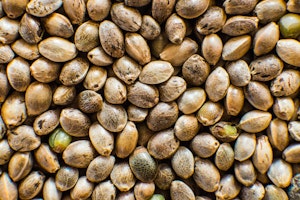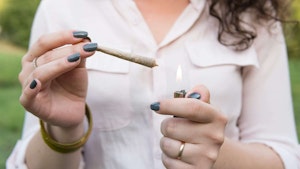
Photo by DANIEL FARÒ
Cannabis & Witchery: How Do The Two Relate?
High spirits: Exploring cannabis in the world of witchcraft.
Throughout history, witches, herbalists, and spiritual practitioners have turned to psychoactive herbs to enhance rituals, promote healing, and access altered states of consciousness.
Cannabis, with its ability to relax the mind and open pathways to creativity and introspection, has long fit into this tradition.
But cannabis isn’t the only herb tied to witchcraft. From mandrake root to mugwort, psychoactive plants have been essential tools in magical practices—each offering unique effects that align with spells, divination, or spirit work.
Historical Usage Of Cannabis In Witchery

In ancient times, cannabis found its place in mystical practices, notably in Chinese and European rituals, as well as in Scythian funeral rites for kings. The plant was revered by shamans, helping them attain a higher state of consciousness in sacred rituals, with its usage tracing back to 5000 B.C.
However, during the Middle Ages, the narrative of cannabis in witchcraft became less clear. While European witches were known to brew hallucinogenic concoctions, the inclusion of cannabis among more commonly used hallucinogens like datura, belladonna, henbane, and mandrake remains ambiguous.
Cannabis was traditionally paired with other herbs in magical potions and spells. Yet, its use became more restrained during the Middle Ages following a ban on the plant by Pope Innocent VIII. Despite this restriction, witches continued their mystical practices using other hallucinogenic herbs.
Fast forward to the modern era, the legacy of cannabis in witchery endures. Modern witches often beckon cannabis into their solitary meditations or as a key to unlocking doors to the spirit realm.
Psychoactive Herbs Commonly Associated With Witchcraft
Aconite (Wolfsbane)

Aconite, also known as Wolfsbane, carries a deadly reputation and a rich lore in witchcraft. Often associated with shape-shifting myths and protection spells, Aconite was believed to have the power to transform humans into werewolves. Its lethal nature underscores the perilous yet profound relationship between witchcraft and the botanical realm.
Belladonna (Deadly Nightshade)

Belladonna, with its dark berries and hallucinogenic properties, has been a staple in the witch’s apothecary for centuries. Known for its ability to induce visions, it was often used in rituals and spells. However, its potency is not to be underestimated, as the margin between a psychoactive and a lethal dose is exceptionally narrow. The deadly allure of Belladonna encapsulates the dangerous dance between the mystical and the mortal.
Datura

Datura, with its beautiful yet deadly flowers, has been used by witches and shamans for centuries. Known for its potent hallucinogenic effects, it was often employed to induce visions or communicate with the spirit realm. The danger of Datura is profound, with many a tale told of those who ventured too far and succumbed to its toxic embrace.
Henbane

Much like Belladonna, Henbane carries a sinister yet significant legacy within witchcraft. Known for inducing hallucinations and a trance-like state, it was often utilized in rituals and magic. Its psychoactive properties stem from the alkaloids hyoscyamine and scopolamine. The danger of Henbane mirrors that of Belladonna, with a fine line separating hallucination from fatal consequences.
Mandrake

The Mandrake root, bearing a peculiar resemblance to the human form, has been steeped in folklore and witchcraft for centuries. Its hallucinogenic properties, attributed to the alkaloids it contains, made it a sought-after component in ancient rituals. The mystique of the Mandrake extends from its use in love spells to its purported ability to divine the future.
The Mandrake root, bearing a peculiar resemblance to the human form, has been steeped in folklore and witchcraft for centuries. Its hallucinogenic properties, attributed to the alkaloids it contains, made it a sought-after component in ancient rituals. The mystique of the Mandrake extends from its use in love spells to its purported ability to divine the future.
Mugwort

Mugwort is a gentler herb on this list, known for its ability to enhance dreams and promote lucid dreaming. Its use in pagan practices and witchcraft for dream magic and divination has a rich historical foundation. Mugwort’s softer, psychoactive touch offers a less perilous path for those venturing into the botanical mysteries of witchcraft.
Wormwood

Wormwood’s historical association with divination and the spirit realm made it a notable herb in the witch’s garden. Its use in concoctions was believed to help witches and seers connect with supernatural entities or divine the future. Although less dangerous than the likes of Belladonna or Datura, Wormwood’s psychoactive properties are still to be approached with caution.
Herb Recommended Products:
READ MORE










